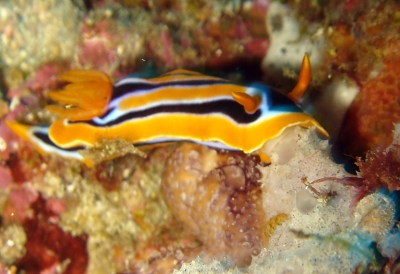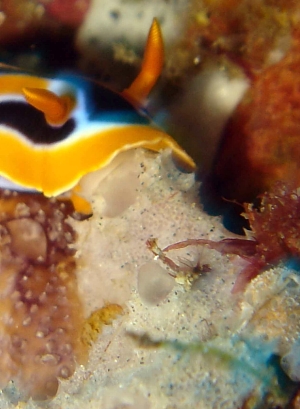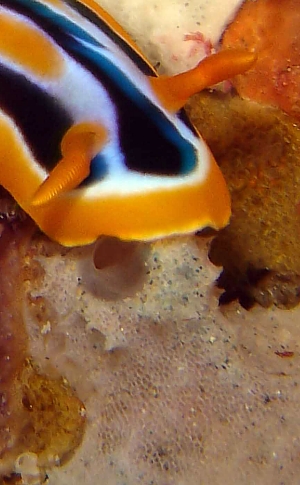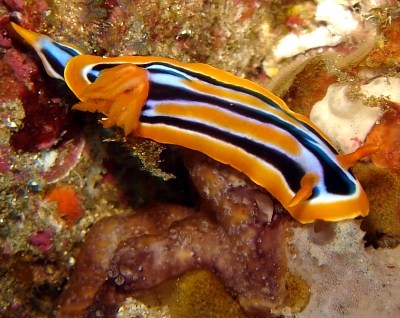Chromodoris hamiltoni feeding on various sponges
September 10, 2008
From: Colin Ogden

Concerning message #20503:
Hi Bill,
Recently I have been trying to collect some photos of Chromodoris hamiltoni feeding. I have some interesting ones that I would like to share with you. The first photos in this message show it feeding on a grey sponge. [See also messages #21876, #21877, #21878, #21879.]
Locality: Sodwana Bay, 15 metres, South Africa, Indian, 26 Nov 2007, reef. Length: 25 mm. Photographer: Colin Ogden.
Regards,
Colin
scubaco@iafrica.com



Dear Colin,
Thanks very much for this series of photos. I'll discuss the significance of all these records here rather than spread the story thinly over the other messages. Firstly, the photos in this message show C. hamiltoni feeding on a sponge which clearly includes sand grains in its skeletal structure, which suggests it is either a thorectid or the related family Irciniidae. This seems to be a different species to the greyish black thorectids already reported for this species, so adds to the accumulating knowledge on the biology of this species.
When I published the review on chromodorid feeding last year (Rudman & Bergquist, 2007), the only thing we knew about the food of C. hamiltoni was from a scientific article by Pika & Faulkner (1995) reporting the presence of chemicals in the skin, and spicules in the stomach, typical of the bright red sponge Latrunculia [which is now considered to be a species of Negombata]. Although this is an unusual sponge for chromodorids to feed on, we now know that a number of similarly coloured species, such as C. quadricolor, also feed on species of Negombata, and also on blackish species of quite unrelated dictyoceratid sponges of the family Thorectidae. It seems this group of chromodorids have chosen these sponges because of the presence of powerful antifeedant molecules called latrunculins, which are found in both sponge groups. In the last year we have had messages to the Forum suggesting C. hamiltoni possibly feeds on another thorectid similar to Phyllospongia [#20503 ] and two messages associating C. hamiltoni with both the red Negombata and a dark grey thorectid, possibly Petrosaspongia or Semitaspongia [messages #20505; 21555]. Your messages confirm feeding on Negombata [#21876], and a dark grey thorectid [#21877; [#21878 ]. In summary, these records of yours are a valuable addition to our knowledge of the natural history of this species.
When the two scientific papers listed below were published, the chemicals found in C. hamiltoni were very puzzling as they did not fit the normal pattern which was emerging for species of Chromodoris. Now that we know that there is a group of species which 'break the rules', evidence such as yours, showing just what sponges are eaten by this nudibranch, are showing us that there is a pattern to their food choice, but it is a little more complicated than we first thought.
- McPhail, K. & Davies-Coleman, M.T. (1997) New spongiane diterpenes from the East African Nudibranch Chromodoris hamiltoni. Tetrahedron, 53(13): 4655-4660
- Pika, J. & Faulkner, D. J. (1995) Unusual chlorinated Homo-Diterpenes from the South African nudibranch Chromodoris hamiltoni. Tetrahedron, 51, 8189–8198.
- Rudman, W. B. & Bergquist, P. R. (2007) A review of feeding specificity in the sponge-feeding Chromodorididae (Nudibranchia: Mollusca). Molluscan Research, 27(2): 60-88.
Best wishes,
Bill Rudman
Related messages
-
Chromodoris elisabethina? from South Africa
From: Henning Brodersen, May 5, 2010 -
Chromodoris hamiltoni from Madagascar
From: Sully Bachel, May 21, 2009 -
Chromodoris hamiltoni tasting? a hydroid.
From: Colin Ogden, September 10, 2008 -
Chromodoris hamiltoni feeding on black sponge? [2]
From: Colin Ogden, September 10, 2008 -
Chromodoris hamiltoni feeding on black sponge? [1]
From: Colin Ogden, September 10, 2008 -
Chromodoris hamiltoni feeding on orange sponge
From: Colin Ogden, September 10, 2008 -
Chromodoris hamiltoni? from South Africa
From: Sylvain Le Bris, May 1, 2008 -
Re: More Chromodoris hamiltoni from Tofo, Mozambique
From: Colin Ogden, April 28, 2008 -
Orange form of Chromodoris hamiltoni
From: Colin Ogden, April 28, 2008 -
Variations in Chromodoris hamiltoni
From: Colin Ogden, April 28, 2008 -
Re: More Chromodoris hamiltoni from Tofo, Mozambique
From: Natasja Vandeperre, August 29, 2007 -
More Chromodoris hamiltoni from Tofo, Mozambique
From: Natasja Vandeperre, August 26, 2007 -
Another Chromodoris hamiltoni from Tofo, Mozambique
From: Natasja Vandeperre, August 22, 2007 -
Chromodoris hamiltoni feeding? from Mozambique [1]
From: Natasja Vandeperre, August 22, 2007 -
Chromodoris hamiltoni & C. quadricolor near Pemba?
From: Rob Veelenturf, April 17, 2006 -
Chromodoris elisabethina from South Africa
From: Riaan Marx, April 22, 2005 -
Chromodoris hamiltoni from Reunion Island
From: Philibert Bidgrain, March 9, 2005 -
Chromodoris hamiltoni from Mozambique
From: Charles Rowe, January 28, 2005 -
Chromodoris hamiltoni from Sodwana
From: Charles Rowe, October 8, 2003 -
Chromodoris hamiltoni from Pemba
From: Paul Young , November 18, 2002 -
Chromodoris hamiltoni from South Africa
From: Linda Penny, May 21, 2002 -
Chromodoris hamiltoni from east Africa
From: Bernard Picton, July 5, 2001 -
Pale version of Chromodoris hamiltoni?
From: Valda Fraser, May 6, 2000 -
Chromodoris hamiltoni? from South Africa
From: Valda Fraser, May 5, 2000 -
Colour variation in Chromodoris hamiltoni
From: Valda Fraser, February 14, 2000 -
Chromodoris hamiltoni from South Africa
From: Valda Fraser, February 11, 2000
